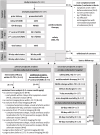Andexanet alfa in patients with factor Xa inhibitor-associated intracranial hemorrhage: The prospective observational multicenter ASTRO-DE study
- PMID: 39834067
- PMCID: PMC12264301
- DOI: 10.1177/17474930251317385
Andexanet alfa in patients with factor Xa inhibitor-associated intracranial hemorrhage: The prospective observational multicenter ASTRO-DE study
Abstract
Background: Hematoma expansion after intracranial hemorrhage (ICH) in anticoagulated patients significantly influences clinical outcomes and mortality, emphasizing the need for effective reversal agents. Andexanet alfa is a specific reversal agent for factor Xa-associated major bleeding.
Aims: The Andexanet alfa: non-interventional study at STROke centers in Germany (Deutschland, DE) (ASTRO-DE) study collected real-world evidence on the effect of andexanet alfa on mitigating hematoma expansion and altering prognosis in rivaroxaban- or apixaban-treated patients with ICH.
Methods: ASTRO-DE was a prospective non-interventional cohort study conducted at 25 certified stroke centers in Germany. The primary outcome was the hematoma volume change and the proportion of patients with hematoma growth ⩽33% within 12-72 h or until first control imaging. Secondary endpoints included in-hospital thromboembolic events and mortality up to 90 days.
Results: A total of 137 patients (47.4% male, mean age = 80.0 years) with ICH (92.6% spontaneous, 87.4% intracerebral), mean National Institutes of Health Stroke Scale (NIHSS) on admission of 11.2 points, and mean initial hematoma volume of 26.5 mL (median = 14.1 mL) were analyzed. Ninety patients (65.7%) suffered ICH while treated with apixaban and 47 (34.3%) with rivaroxaban. The median time between symptom onset and application of andexanet alfa was 3.3 h, door-to-needle time was 1.1 h. The mean change in hematoma volume until the first control imaging, conducted after a median of 15.6 h, was 2.3 mL (95% confidence interval (CI) = 0.4-4.2), while the change within 12-72 h was 1.8 mL (95% CI = 0.4-3.2). Hematoma growth ⩽33% was achieved in 90.3% of the 93 evaluable patients based on first control imaging and in 90.5% of the 63 evaluable patients, considering only imaging performed within the 12-72 h window. During hospitalization, death occurred in 30/137 patients (21.9%) and 17 thromboembolic events in 11/137 (8.0%) patients. The 90-day mortality was 47/128 (36.7%).
Conclusion: ASTRO-DE is the first prospective observational study systematically collecting standardized clinical routine data with andexanet alfa treatment. The study demonstrated favorable hemostasis and minimal mean hematoma volume growth in patients with ICH associated with apixaban or rivaroxaban treatment.Data access statement:Data are available upon reasonable request by contacting the corresponding author.
Keywords: Intracranial hemorrhage; andexanet alfa; anticoagulation; apixaban; hemostasis; rivaroxaban.
Conflict of interest statement
Declaration of conflicting interestsThe author(s) declared the following potential conflicts of interest with respect to the research, authorship, and/or publication of this article: In the last 3 years, H.-C.D. received honoraria for his involvement in clinical trials, contribution to advisory boards and oral presentations from Abbott, Boehringer Ingelheim, and WebMD Global. Boehringer Ingelheim and Alexion, AstraZeneca Rare Disease, provided financial support for his research projects. He received research grants from the German Research Council (DFG) and German Federal Ministry of Education and Research (BMBF). D.G.N. received honoraria for contribution to advisory boards and oral presentations from AstraZeneca, Boehringer Ingelheim, Bristol Myers Squibb (BMS)/Pfizer, and Daiichi Sankyo. S.P. is Steering Committee member of the German Stroke Registry. Outside of the submitted work, he received research support from BMS/Pfizer, Boehringer Ingelheim, Daiichi Sankyo, German Federal Joint Committee Innovation Fund, BMBF, Helena Laboratories, and Werfen and speakers’ honoraria and consulting fees from Alexion, AstraZeneca, Bayer, Boehringer Ingelheim, BMS/Pfizer, Daiichi Sankyo, Portola, and Werfen. M.M.G. was funded by the Ellen-Schmidt-Scholarship of Hannover Medical School. I.L.M. received speakers’ honoraria from BMS/Pfizer and AstraZeneca. The other authors report no conflicts of interest.
Figures





References
-
- Diener HC, Ntaios G, O’Donnell M, Easton JD. Non-vitamin-K oral anticoagulants (NOACs) for the prevention of secondary stroke. Expert Opin Pharmacother 2018; 19: 1597–1602. - PubMed
-
- Lopes RD, Guimaraes PO, Kolls BJ, et al. Intracranial hemorrhage in patients with atrial fibrillation receiving anticoagulation therapy. Blood 2017; 129: 2980–2987. - PubMed
-
- Apostolaki-Hansson T, Ullberg T, Norrving B, Petersson J. Prognosis for intracerebral hemorrhage during ongoing oral anticoagulant treatment. Acta Neurol Scand 2019; 139: 415–421. - PubMed
-
- Purrucker JC, Haas K, Rizos T, et al. Early clinical and radiological course, management, and outcome of intracerebral hemorrhage related to new oral anticoagulants. JAMA Neurol 2016; 73: 169–177. - PubMed
Publication types
MeSH terms
Substances
LinkOut - more resources
Full Text Sources

